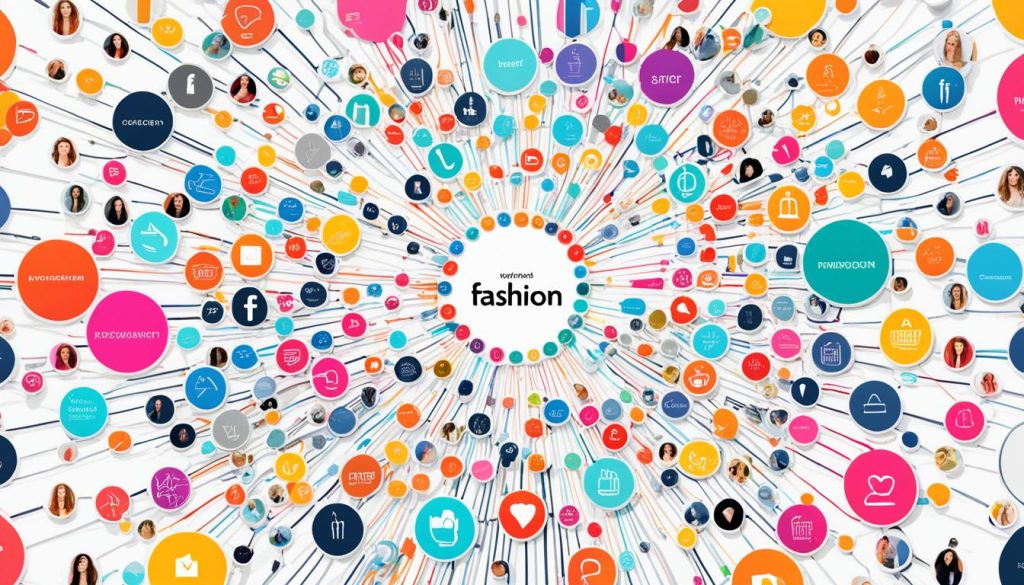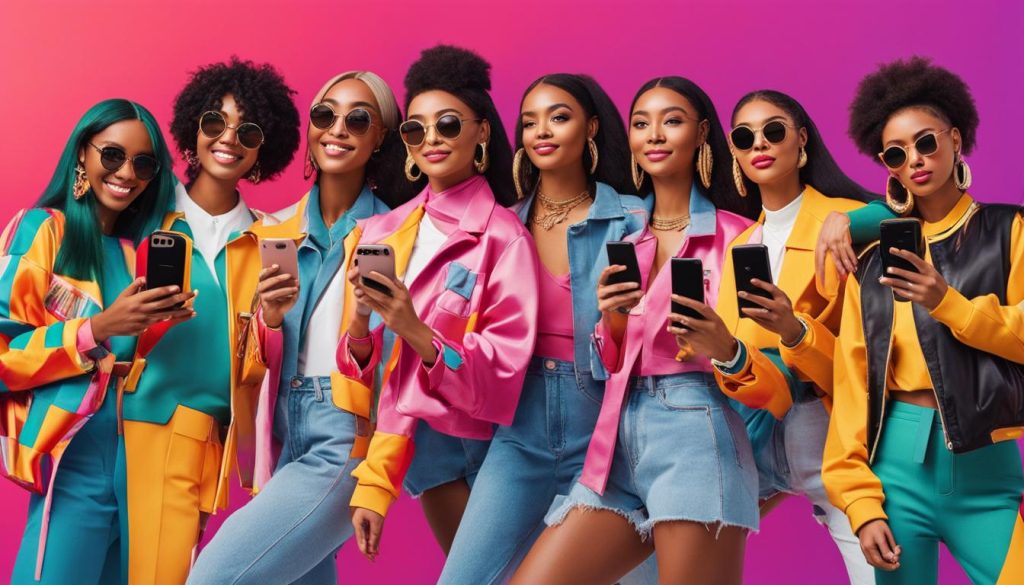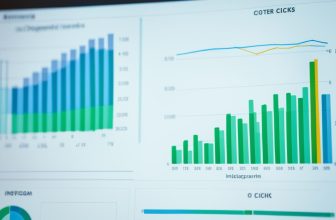The fashion industry, with its vibrant tapestries of creativity and innovation, has undergone a definitive transformation, and social media has been the vibrant catalyst. Platforms such as Instagram not only enrich the visual feast we indulge in daily but have irrefutably altered the very fabric of this dynamic industry. The social media impact on fashion industry trends is unequivocal; fashion influencers on social media bridge the gap between runway elitism and street-style savvy enthusiasts, truncating the journey for trends and making style accessible with just a click.
Recognizing the pull of scroll-stop visuals, illustrious brands and upstarts alike curate their online presence to resonate with the digital zeitgeist. Models and moguls step back as fashion influencers on social media claim the throne, their carefully captured looks dictating consumer desires. This seismic shift showcases the power of virtual connectivity—the potency of a post, the virality of a video, and the collective curation of what’s chic on digital platforms. No conversation about the zeitgeist of fashion industry trends influenced by social media is complete without acknowledging the power players—influencers who, with their discerning eye, have heralded a new era in fashion.
Key Takeaways
- Influencers now wield substantial influence over consumer fashion choices.
- Instagram has become a pivotal platform in redefining fashion industry dynamics.
- Direct paths from inspiration to purchase have been carved out via social media.
- Today’s fashion domains are driven by the immediacy and connectivity of social media.
- Engagement on social media translates into tangible commercial success for brands.
- Fashion narratives are now crowd-sourced, collaborative, and democratic.
The Evolution from Traditional Gatekeepers to Social Media Influence
As the fashion industry witnesses a significant transformation, the deep-rooted position of conventional fashion publications and runways as the primary trendsetters has evolved. Social media, particularly Instagram, has emerged not only as a primary source of inspiration but also as a strategic sales channel, emphasizing the power of visuals in shaping consumer behavior. This pivot points towards a change in the very foundation of fashion marketing and branding.
Decline of Traditional Fashion Authorities
Gone are the days when seasonal collections waited for applause from an exclusive audience of fashion editors and buyers. Where once glossy magazine spreads dictated the ‘must-haves’ of the season, now fashion brands converge on social media platforms to engage with their audience. Traditional gatekeepers have conceded ground to digital influencers and analytics-driven trends, marking an era where consumers possess more say in what is deemed fashionable.
The Rise of Instagram and Visual Dominance
Instagram’s ascent as a visual powerhouse has redefined the paradigm of brand-consumer interactions. Fashion brands adeptly tailor their social media strategy to the platform’s highly visual interface, allowing them to showcase their aesthetic directly to consumers. The swift scroll-through culture of Instagram promotes an image-first approach, compelling brands to become more visually inventive and emotionally resonant in their communications. A picture-perfect Instagram feed has become synonymous with brand identity, succinctly conveying style narratives formerly spread over pages of editorials.
The implication of Instagram within the fashion industry transcends mere aesthetics; the platform’s features such as Stories, IGTV, and Reels present dynamic opportunities for brands to construct a versatile and engaging social media presence. These features facilitate a level of storytelling and interaction that was previously unattainable, shaping a social media strategy for fashion brands that is interactive, direct, and personalized.
As the fabric of fashion’s authority continues to be rewoven, so too does the strategy of brands that once relied solely on print campaigns and runway shows. Instagram has ushered in an era where visibility equates to influence, giving fashion brands direct access to a global audience and enabling them to rise with visual fluency in a digital-first marketplace.
Social Media Impact on Fashion Industry
The transformative effects of social media in redefining the fashion sector cannot be understated. To understand the social media marketing for the fashion industry, it’s essential to consider how various platforms, especially Instagram, have become indispensable tools for brands. These platforms facilitate instantaneous communication with audiences worldwide, putting a spotlight on fresh trends, allowing for immediate feedback and fostering a vibrant community of fashion enthusiasts.
Platforms such as Instagram not only serve as a vehicle for marketing and trendsetting but also function as a barometer for consumer sentiment and preferences. Through likes, comments, and shares, fashion brands can tap into real-time analytics that inform their design and marketing strategies. This intricate web of interaction ensures that social media is not just a one-way promotional channel but a dynamic, responsive conduit shaping the very heartbeat of the fashion industry.

Engagement on social media goes beyond the typical marketing rhetoric, evolving into a storytelling platform where every collection, piece, or campaign can express a narrative that resonates with the target audience. This narrative is powerful, driving consumer behavior and brand loyalty to unprecedented heights. Moreover, social media gives voice to diverse perspectives in fashion, contributing to the sector’s previously unseen levels of inclusion and diversity.
| Marketing Aspect | Effect of Social Media |
|---|---|
| Brand Awareness | Exponential increase due to viral campaigns and hashtag trends |
| Consumer Engagement | Direct interaction with audience via comments, stories, and live videos |
| Trend Forecasting | Real-time insight through user-generated content and influencer partnerships |
| Product Marketing | Immersive, visually-driven campaigns with instant call-to-action features |
| Feedback Loop | Quick consumer feedback leading to rapid iterations and customization |
Ultimately, social media marketing for the fashion industry has paved the way for an agile, trend-responsive market that is always switched on. The continual interaction between brand and consumer has created a symbiotic relationship where each influences the other, and the fashion landscape thrives on this dynamic exchange. This interaction is not just changing how fashion does business; it’s changing the very way we perceive, engage with, and consume fashion.
Fashion Industry Trends Influenced by Social Media
The fashion landscape is evolving at an unprecedented rate, courtesy of the explosive influence of social media platforms. Trends that once trickled down through a slow-moving pipeline are now flooding the market in real-time, thanks in large part to the powerhouses of TikTok and Instagram.

Social media fashion trends are not just changing how consumers perceive style but also how brands approach the creative process and marketing. The fashion industry’s collaboration with TikTok has created a symbiotic relationship that fast-tracks trends from the conceptual stage to consumer closets.
Micro Influencers and Consumer Trust
The rise of micro influencers on social media has woven a new thread into the fabric of fashion marketing. These key players achieve high engagement rates by leveraging their niche followings and fostering an environment of trust, authenticity, and personal connection with their audience. Brands effectively tap into their influence to create a more personalized consumer experience.
Speed of Trend Adoption and Product Lifecycle
The rapid rate at which products gain and lose popularity is a palpable manifestation of the impact social media has on the fashion industry. The cycle from trend emergence to widespread adoption can occur within a mere fraction of the traditional timeframe, prompting brands to remain agile and responsive to the swift currents of consumer interest.
| Trend | Time to Peak (Pre-Social Media) | Time to Peak (Social Media Era) |
|---|---|---|
| Boho Chic | 1.5 years | 6 months |
| Extreme Athleisure | 1 year | 3 months |
| Eco-Friendly Fabrics | 2 years | 8 months |
Democratization of Fashion through Social Platforms
The emergence of social media has brought about a radical transformation in the fashion industry, leading to the democratization of fashion. No longer is the industry circumscribed by the gates of traditional power structures; instead, social media platforms have become the springboards for emerging talent and innovation. The impact of this change is profound, redefining not only how fashion is sold, but also how it is conceived and embraced by a global community.
Expansion of Opportunities for Independent Designers
Independent designers are finding their voice and audience through the use of platforms such as Instagram. This venue allows them to exhibit their work without the need for excessive funds usually required for advertising and shows. Pieces that may have never seen the light of day in a traditional setting can find a niche following, enabling designers to build their brands in an authentic and organic way.
- Presence on social media offers exposure to diverse markets
- Engagement with the audience gives immediate feedback and creates relationships
- Storytelling through platforms adds depth to the brand, enhancing customer loyalty
Shift from Exclusivity to Inclusivity
In previously inaccessible industry spaces, we’re now witnessing a surge of inclusive practices. Influencers and content creators from varied backgrounds are injecting new perspectives into the fashion dialogue. It’s more than just aesthetics; it’s about representing a wide spectrum of society — a turn from exclusivity to inclusivity where styles across the board gain visibility and popularity.
“Fashion no longer trickles down; it bubbles up from the streets to the runways, through the vibrant exchange on social platforms.”
| Traditional Fashion | Democratized Fashion |
|---|---|
| Seasonal collections | Continuous content creation |
| Exclusive runway shows | User-generated fashion shows |
| Editorial gatekeeping | Community-driven trends |
| Niche designer dominance | Rise of independent creators |
| High entry costs | Low barrier to entry |
The social media impact on the fashion industry is not a mere trend but a renaissance of creative freedom and a platform for advocating sustainability and ethical practices. This move towards the democratization of fashion is a testament to the transformative power of technology and human connectivity.
Integration of E-commerce and Social Media Marketing Strategies
The digital era has witnessed the seamless integration of social media marketing with e-commerce, creating an ecosystem where the fashion industry is thriving with innovative sales approaches. Insightful understanding of social media advertising for the fashion industry has become imperative for brand success. Beneath the surface of engaging posts and viral campaigns lies a strategic mastery of social media analytics for fashion brands, which are pivotal in shaping the future of fashion retail.
Shoppable Posts and Direct Consumer Engagement
Capitalizing on the power of social media, the fashion industry has introduced shoppable posts—a game-changer in transforming followers into customers. This feature not only simplifies the purchase process by minimizing the steps from discovery to transaction but also leverages the power of impulse purchases driven by the fear of missing out (FOMO). The direct line of communication established through these engagements is invaluable for brands seeking a deeper connection with their audiences.
Leveraging Social Media Analytics for Fashion Brands
More than ever, fashion labels rely on social media analytics to inform their marketing and inventory strategies. The data harvested from these platforms offers a rich understanding of consumer behavior and trend reception. Below is a table showcasing a comparative overview of key metrics fashion brands analyze to optimize their social media presence and advertising effectiveness.
| Metrics | Purpose | Benefits |
|---|---|---|
| Engagement Rate | Measure audience interaction with content | Improves content strategy to increase consumer interaction |
| Click-Through Rate | Gauge the effectiveness of calls to action | Enhances ad targeting and conversion potential |
| Conversion Rate | Reflect the percentage of consumers who take the desired action | Helps fashion brands adjust campaigns to boost sales |
| Customer Sentiment | Analyze social comments and feedback | Enables brands to swiftly adapt to consumer expectations |
By harnessing the power of these analytics, fashion brands are able to tailor their social media advertising campaigns to what truly resonates with their audience. As a result, this precise targeting not only enhances the customer shopping experience but also sustains a competitive advantage in the ever-evolving fashion industry.
Conclusion
The interplay between social media and the fashion industry has evolved into a transformative force, dictating the rhythm at which style and commerce pulsate. Within this landscape, every aspect of the fashion process, from the initial spark of a designer’s inspiration to the moment a shopper clicks ‘buy’, has been restructured under the pervasive influence of platforms like Instagram and TikTok. It’s no longer a burgeoning trend but an established norm that a social media strategy for fashion brands is indispensable for success in today’s digital-centric world.
The dynamic between consumers and brands has notably shifted, favoring direct dialogue and the shared evolution of fashion trends. No longer are designs solely dictated by the industry; the voice of the consumer echoes loudly, guiding brands towards what’s in demand. Furthermore, the strong wave of sustainable fashion has been amplified by social media, promoting not only style but also substance, as brands commit to transparency and ethical practices under the watchful eyes of an engaged audience. These initiatives are not only a response to consumer demands but also a reflection of a collectively heightened consciousness about the planet’s future.
Indeed, while challenges persist in terms of addressing the environmental impact that this rapid content generation and consumption entail, opportunities for innovation within sustainability efforts are rife. As the curtain falls on our exploration, it’s evident that the fusion of social media and fashion has delivered a new paradigm—one where agility and sustainability coexist, enhancing the industry’s capacity to develop a responsive and responsible sartorial future. Brands poised to leverage these tools will undoubtedly carve out robust paths to garner consumer loyalty and secure their place in the fashion zeitgeist of tomorrow.
FAQ
Social media has drastically transformed the fashion industry by shifting the power dynamics to platforms like Instagram, which influence purchasing decisions and trend setting. The ability for brands to engage directly with consumers through visual storytelling and influencers has reshaped marketing strategies and democratized fashion.
The rise of social media, particularly Instagram, has led to a decline in traditional fashion authorities like magazines and retailers. Brands now create direct relationships with consumers through social media, harnessing its visual appeal and bypassing old gatekeeping structures, thus empowering consumers and influencers to have more say in fashion trends and decisions.
What is the significance of Instagram in the fashion industry?
Instagram’s visual-centric platform plays a significant role in the fashion industry by offering brands the opportunity to showcase their products in a visually appealing manner. With its large user base and engagement, Instagram has become a key player in influencing fashion trends and consumer buying behavior.
Platforms like TikTok have shortened the fashion trend lifecycle by rapidly popularizing micro trends. This has led to the fashion industry needing to be more agile and responsive to quickly changing consumer interests, as trends can gain massive popularity in a matter of months or even weeks.
What role do micro influencers play in consumer trust within the fashion industry?
Micro influencers have gained trust among consumers due to their personal engagement and perceived authenticity. They tend to have niche, dedicated followings and can offer a more relatable perspective compared to traditional celebrities, making them highly effective for brands looking to connect with specific audiences.
Democracy through social media has made fashion more accessible and inclusive, allowing independent designers to reach global audiences without the need for large marketing budgets. It has also enabled consumers to actively participate in shaping fashion trends, no longer solely relying on the industry to dictate style.
Social media has merged with e-commerce by introducing shoppable posts, which allow consumers to instantly purchase products seen on platforms like Instagram. This integration has revamped fashion marketing strategies by emphasizing direct consumer engagement and leveraging FOMO to drive sales.
Fashion brands use social media analytics to gain insights into consumer behavior, preferences, and engagement. Analytics help brands to fine-tune their marketing strategies, predict upcoming trends, target their advertising more effectively, and manage inventory based on consumer interest.







